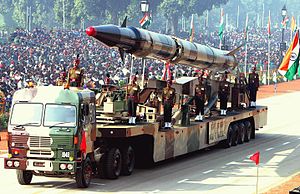Agni-II
| Agni-II | |
|---|---|

An Agni-II on a road-mobile launcher displayed at the Republic Day Parade 2004.
|
|
| Type | Medium Range Ballistic Missile |
| Place of origin | India |
| Service history | |
| In service | (Test by DRDO)11 April 1999, (Test by SSC)09 November 2014 |
| Used by | Indian Army |
| Production history | |
| Designer | Defence Research and Development Organisation (DRDO) |
| Manufacturer | Bharat Dynamics Limited |
| Unit cost | ₹25–35 crores or US$5.6–6.6 million |
| Specifications | |
| Weight | 16,000 kg (Include 1,000 kg warhead) |
| Length | 21 m |
| Diameter | 1.3 m |
| Warhead | Strategic nuclear (15 kt to 250 kt), conventional HE-unitary, penetration, sub-munitions, incendiary or fuel-air explosives |
|
|
|
| Engine | Two-and-half-stage solid propellant engine |
| Wingspan | Unknown |
|
Operational
range |
2,000–3,000 km |
| Flight ceiling | 405km |
| Flight altitude | 230km |
| Speed | ~mach 12 or 3.9 km/s (Agni-II) |
|
Guidance
system |
Ring Laser Gyro- INS (Inertial Navigation System), optionally augmented by GPS terminal guidance with possible radar scene correlation |
| Accuracy | 30–40 m (latest version) |
|
Launch
platform |
8 x 8 Tata TELAR (Transporter erector launcher) Rail Mobile Launcher |
Agni-II (Sanskrit: अग्नि fire), is a strategic ballistic missile. The Agni missile family is envisaged to be the mainstay of the Indian missile-based strategic nuclear deterrence. The Agni-II is a medium-range ballistic missile (MRBM) with two solid fuel stages and a Post Boost Vehicle (PBV) integrated into the missile's Re-entry Vehicle (RV). The Agni's manoeuvring RV is made of a carbon-carbon composite material that is light and able to sustain high thermal stresses of re-entry, in a variety of trajectories. The Agni-IIA is a more advanced version of Agni-II, albeit with more sophisticated and lighter materials, yielding a better range and operating regime. Agni-IIA was later renamed as Agni-IV plugging the gap between Agni-II and Agni-III. While the first test of Agni-IV in December 2010 was a failure, the second test flight in November 2011 was a success Agni-II, developed as part of medium- and long-range Agni series of missile systems, has already been inducted into the Armed Forces.
On 17 May 2010, the trial was conducted with a special strategic command force (SSC) of nuclear-capable Agni-II ballistic missile, with a range of 2,000 kilometres from the Wheelers Island off Orissa coast thus making Agni-II missile operational by army. The missiles are operated by the 335 Missile Group at Secunderabad using 12 TEL vehicles.
During the 1990s, India's security situation gradually worsened with security challenges from China, blatant Chinese nuclear and missiles proliferation to Pakistan, and mutual proliferation between Pakistan and North Korea. The strategic redline was crossed in 1998 when Pakistan tested nuclear capable Ghauri missile, that could threaten India's heartland. The international complicity in allowing nuclear proliferation by proxy into the hands of Pakistan and ability to deliver it over long ranges, obtained by trading in black-market North Korean No-Dong missiles, in return for Pakistani nuclear design and enrichment equipment by the nuclear and missile black-market run by Pakistani scientist A.Q. Khan and the Pakistani Military. These developments forced India to go fully nuclear, resulting in the Pokhran-II nuclear test series and its weaponisation by developing the Agni family of ballistic missiles that could deliver a variety of payloads over long ranges.
Quick deployment of the Agni-II was possible, by building on the earlier Agni-TD program that provided proven critical technologies and designs required for long-range ballistic missiles. Thus when the decision was made to build the Agni weapon system, some quick optimisation and ruggedisation was done to the basic '1980 vintage' design, including a solid fuelled second stage. The re-entry vehicle (RV) and avionics were brought up to state-of-the-art levels. The Pokhran-II nuclear test proved a family of more powerful and lighter nuclear weapons; the 200 kt thermonuclear weapon is far lighter compared to 1,000 kg earlier budgeted for the 200 kt boosted nuclear weapon. Thus a high-yield weapon configuration now assumes a payload of 500 kg, including weapon and RV. However, in the interest of rapid development, the basic design that was earlier developed continued to be used, keeping the future option open for more optimised missile design and lighter payload.
...
Wikipedia
